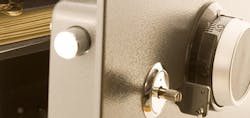RFID for More Foolproof Access
By Aaron Hand, Managing Editor
Nuclear plants, for obvious reasons, require a high amount of access security. In addition to it being vitally important that an engineer be qualified to work on a given process, U.S. nuclear power plants—since the events of Sept. 11, 2001—have become more accountable for security against potential acts of terrorism.
RFID technology is changing the way people are being identified as they pass the guard house for at least one nuclear facility, where system integrator iQuest (www.iquestcorp.com), Alpharetta, Ga., implemented a safer, more foolproof system. Now, instead of the guard walking out to each car to collect and verify IDs (putting him, and the plant, in harm's way), each person's badge has an RFID tag that enables tags to be anywhere in the car and still read by an RFID reader in the guard station.
Although machine access control on a plant floor might not be as dire as access to a nuclear plant, it is increasingly important as factories look for ways to be more cost-efficient and competitive through increased quality control. And the Siemens RFID technology that iQuest employs could be used in much the same way, according to Bob Meads, president and senior software engineer for iQuest. "You could apply this technology pretty much anywhere you want to do access control," he says, noting that badge information could be integrated with any database, controlling access to areas of a plant or to particular parts of a machine.
Ed Housler, factory sensors manager at Siemens Industry (www.industry.siemens.com), points to another customer in the automotive supply industry using the RFID technology to regulate which employees are able to access which machines and perform which operations, whether that's machine setup, program changes, etc.
Such solutions are a more economical answer to increased automation, Housler says, and can save manufacturers money by keeping people from working in areas in which they're not qualified to work.
Euchner developed its inductive RFID key tags, which replace password-based access control, in response to its customers having machine control security issues on the plant floor, says Mark Witherspoon, director of North American automotive operations for Euchner USA (www.euchner-usa.com). "Unauthorized access was causing significant line downtime as well as quality control problems with produced parts," he says.
Although user passwords are the most common way of providing PLC and machine control program security, it is too easy to pass passwords between personnel. RFID technology makes users more accountable with their own access keys or tags, significantly reducing the likelihood that machine access control will be passed around.
"Because the employee does not have access to modify or change their programmed key information, and because they know their personal ID is programmed to the key and logged whenever the key is used, passing of key tags between people is highly unlikely," Witherspoon says. "This allows secure access to critical machine control parameters to be significantly increased."
Some OEMs integrate RFID into their access systems, but the technology is driven more by end users at this point, Housler says. It has been particularly popular with automotive plants, but is catching on in other industries as well, including food and beverage, and healthcare, he adds.
Increasing popularity of RFID-based access control has been driven largely by the economy—from several different angles. In one respect, many factories are downsizing their workforces, and are not always able to get the expertise previously found. Tightened and automated access control tackles areas where error could be introduced into the process, Housler notes. "It's reducing the likelihood that a human can introduce an incorrect parameter into the machine."
In a competitive global marketplace, end users and machine builders need to find ways to improve processes and quality control, while reducing costly downtime, Witherspoon says. "Machine/line downtime can cost end users tens if not hundreds of thousands of dollars per hour," he says. "Quality control problems not only can cost thousands of dollars in containment costs, but can severely damage a company's reputation in the market, and potentially cost them future project work."

